Francesca and Henk-Jan's Backpacking Trip!
Wednesday, September 8, 2010
Pokhara
On the 7th of September the day had finally come for us to leave comfortable Kathmandu behind. We’d spent nearly two weeks in the capital and still had quite a few places left to visit. Francesca had made us a list of places to visit and an estimated needed time for each destination. This way we’d know when we’d be back in Kathmandu to pick up our visas, which we obviously still didn’t have. As far as the 7th was concerned: we wanted to get to Pokhara, further to the west of the country. There were plenty of early tourist buses that would be able to take us there without too much hassle, but Francesca and I were interested in visiting Bandipur, a rural town on a high ridge between the two cities.
Instead of taking the bus we ended up in a taxi arranged by the Avalon House. We bade the staff farewell early that morning and told them we’d be back on the 21st. The drive to Bandipur was terribly uneventful, but fast with only a few short stops. Just past midday we arrived in Bandipur after a bit of a climb to get to the ridge. Bandipur, with its glorious 18th century Newari architecture and medieval atmosphere would definitely be worth spending a few hours in.
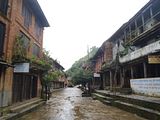
We’d read in the Lonely Planet we could get a guide to take us around the main sights for a good price, so our first goal was the Tourist Information Counter. On our way there we had to find a spot for a toilet-stop for Francesca and walked into one of the hostels in town. Whilst Francesca was surprised to find a Western toilet, I was even more surprised to read the owners were renting out their somewhat basic, but very livable rooms for the grand price of 1 rupee per night. We figured they’d just ask you to eat at their place, but regardless, that would be an amazing deal. Francesca and I thanked the owners for their hospitality and continued our walk on the cobblestones to the Counter.
The lady seemed to know exactly what I was talking about when I asked for a guide, and a man popped up next to her, ready to lead us around. I should’ve asked a few more questions, but didn’t and we ended up following the guide without really knowing what was about to happen. When the man started taking us outside of the village and finally explained we were about to be taken on a 4 hour hike to a nearby temple we quickly turned around and decided to just explore Bandipur on our own. I pulled out the Planet and cooked up a plan of attack.
On the main square we found the pretty Bindebasini Temple, dedicated to Durga. Every evening the village priest comes out and opens the doors of the ornately carved two-tiered temple. Across from it we spotted the Padma library, another typical 18th century Newari wooden building with carved windows and beams. After buying an umbrella to protect us from very likely incoming rain we headed to the Notre Dame School, established by Japanese nuns about 25 years ago. The school wasn’t very special, but seeing the kids playing in their uniforms was neat. Back on the main path we continued east and walked through Balabazaar, a striking arcade of shop-houses formerly occupied by Newari cloth merchants.
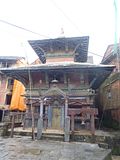
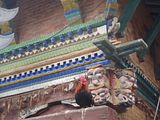
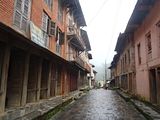
It was simply a pleasure walking through the quiet town, with a barely a soul in sight and nature along with its gorgeous views all around us. Francesca had us stop on several occasions to observe the wildlife. First we watched little ducklings having trouble getting out of the gutter, then there was a staircase full of chicken and lastly we stumbled upon some enormous spiders in their equally enormous spider webs. I managed to lead her past these, with the promise the sights behind them would be worth it. And indeed, the public washing area, known as Tin Dhara (three sprouts) looked interesting. Here, cool, clean spring water from the forest comes down the mountain and is still used by the locals today. We watched for a while, with Francesca freaking out over me wanting to try the water. Of course, in the end I didn’t…
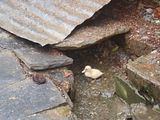
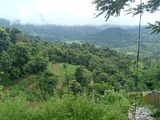
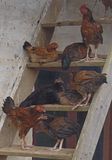
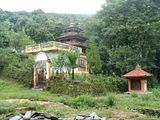
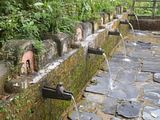
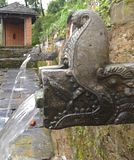
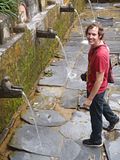
Across from the spouts an ancient Shiva Temple, which, covered in moss, had integrated into its environs entirely. Our next goal was to get back to the village to find some more temples and sights. I had to get Francesca past the spiders again, and kept talking to her to make her forget they were there. My trick worked and she forgot all about them. We headed back to the square and had a drink in the Hill Way Café. The menu looked promising and we vouched to return after visiting the remainder of the sights.
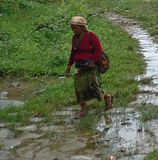
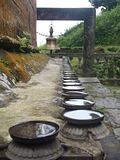

I then took Francesca on a meandering walk to Tundikhel, a wide open space once used for trading. Bandipur had once been part of the trade route between India and Tibet, and traders had gathered here to haggle for goods before embarking on their long treks. Besides the history to the place it’s also an amazing viewpoint that reveals several of the Himalayas’ high peaks on cloudless days. We weren’t that lucky, but still got a wonderful view of the valley below. Furthermore, at the start of the Tundikhel stand five enormous fig trees. They’re not just ordinary trees, as we learned: in Nepali mythology the different types of fig trees are symbols for different Hindu gods, with Vishnu, Brahma and Hanuman all represented.
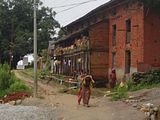
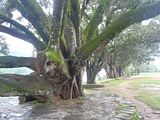
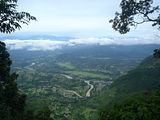
A longer walk would lead us back towards the main bazaar. It was a fairly steep climb at times and Francesca felt a little uncomfortable. We had no choice but to keep going and eventually ended up at a Martyrs Memorial, where I took a few pictures before returning to Francesca and continuing on. Just as we’d reached the highest point of the little climb and had to start descending again Francesca got even less excited about the slippery slopes she had to go down. By now we’d come so far that there was no sense in retracing our steps and we headed down, with me holding her hand. This didn’t stop her from still falling and landing on her bum, right in the middle of a little stream of water. Unavoidably, a wet ass was the result. We joked about that for a while and managed to get down otherwise unscathed.
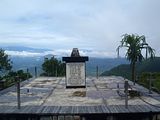
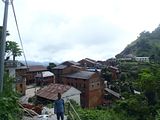
On our way back Francesca and I had a look at the Baralthok, a small and abandoned settlement of the Magar people. Also along the way we found boring army barracks and finally the Khadga Devi Temple -- A 16th century shrine holding the sword of Mukunda Sen, a 16th century king of the ancient kingdom of Palpa. This one was actually worth the wet ass for and we stopped for a while to look at it and its surroundings. Back in town we made our way back to the Hill Way Café and sat down for a sandwich and a thukpa. They took a loooong time to arrive, but were well worth the wait.
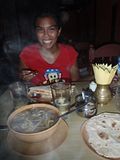
Our driver had faithfully waited for us down at the parking lot and was all too eager to continue the drive to Pokhara. We later learned he still had to make his way back to Kathmandu that same day and had a long day ahead of us. Around 5:00 PM we arrived in Pokhara and had a look for the Peace Eye Guesthouse, which had been recommended to us. The owner led us to his second hostel in the adjoining building, the Rising Moon Guesthouse where we got a spacious fan-room for very little money. I lugged our backpacks upstairs, and we laid down on the comfortable bed to read up on Pokhara and rest up.
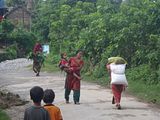
We thought it would be a good idea to immerse ourselves in some local culture on the first evening and found the ’best’ garden and dinner show place. The owner of the Peace Eye told us to head out around 7:00 PM, but we headed out a little early to get some good seats. This turned out to be unnecessary because it was an remained very quiet throughout our meal. Our table appeared okay and the service was pretty swift. Francesca ordered herself a butter chicken and I got some tacos, hoping the chefs could deliver on their promise of good Mexican food. Sadly, I was disappointed by the end result, whilst Francesca couldn’t complain about her decent curry and good naan. The show, however, was an absolute disaster -- the boxes were right in front of us, way too loud and distorted, the instruments and the singers off-key and the dancing out of tune and uncoordinated. What a hot mess… After we finished our food we quickly packed our bag and left.
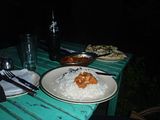
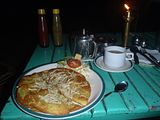
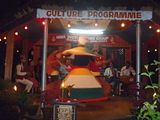
For the 8th we had great plans. After a quick bite from the AM/PM Café down the road from our guesthouse I talked to a local cabdriver and asked him to take us around all of Pokhara for the day. After a bit of haggling we reached a deal and off we went. Our first stop would be the Regional Museum, devoted to the history and culture of the Pokhara Valley. Whilst the tiny museum had seen better days (about 2 decades ago) it was still interesting to walk through, watch the pictures, dioramas and artifacts. Highlights were a little native hut, clothing and an ancient collection of black-and-white pictures of tribes people. After a quick 15 minutes we were done with our first museum of the day and on our way to the second one.
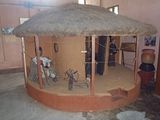
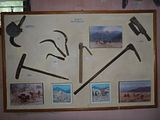
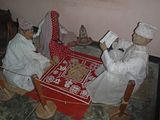
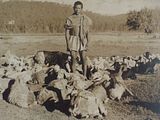
The Gurkha Museum wasn’t very far away and proved to be much more interesting than the previous museum. The Gurkha Museum is dedicated to the Gurkhas, first known as a people of Nepal who took their name from the eighth century Hindu warrior-saint Guru Gorakhnath, and later used for the Nepalese branch of the British Indian Army. Here’s a little summary about the Gurkhas and their history: “In the Gurkha War (1814–1816) [the Gurkhas] waged war against the British East India Company army. The British were impressed by the Gurkha soldiers and after reaching a stalemate with the Gurkhas made Nepal a protectorate. Much later, they were granted the right to freely hire them as mercenaries from the interior of Nepal. After the British left India, Gorkhalis continued seeking employment in British and Indian forces, as officers and soldiers. Under international law, present-day British Gurkhas are not treated as mercenaries but are fully integrated soldiers of the British Army, operate in formed units of the Brigade of Gurkhas, and abide by the rules and regulations under which all British soldiers serve.” To this very day young Nepalese men undergo rigorous selection processes to become one of the select few to be accepted in the Gurkha training academy -- and a guaranteed better future for the soldier and his family.
The first floor of the museum was dedicated to the different battles the Gurkhas had taken part in. It started with the British Indian Army’s battles in and around Delhi, followed by contributions during both World Wars and much more recent conflicts such as the Gulf War and Iraq War. There were several stories about heroism from Gurkhas who’d gone out of their way for their fellow soldiers and thereby saved lives, whilst sometimes losing their own. Seeing their weapons (amongst which comes the kukhuri, their famous knife), reading those stories and seeing the pictures left quite an impression on me. Francesca, in the meantime, had started feeling progressively worse. I had her sit down for a while, whilst I explored the rest of the museum. The second floor was less interesting, being dedicated to the different companies, their flags and uniforms. I did get to put on their typical hat and made a quick picture of Gurkha Henk before returning to Francesca.
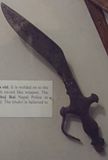
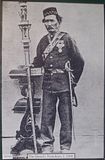

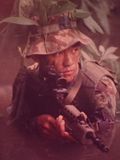
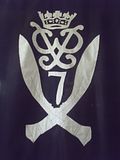
She’d started feeling a tiny bit better, but I still ran out to get her a nice, cold bottle of water. It helped her recover and made it possible for us to have a look at the Seti River, which over the centuries has carved an immensely deep canyon through the heart of the old city. It was pretty cool to see the river raging so many meters below us, whilst we already had descended several meters and were looking up at a small bridge above us. I took Francesca by the arm and led her back to the car, where we asked our driver to take us through Old Pokhara. We’d initially planned on walking around for a while, but with Francesca not feeling too great, were dissuaded and decided to observe the architecture from the comfort of our vehicle.
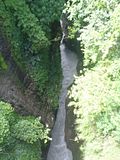
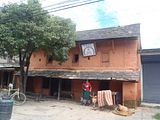
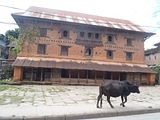
After checking out some more traditional Newari houses our driver stopped near Bhimsen Temple, a simple white temple in the middle of the road dedicated to the Newari god of trade and commerce. Not too far from the temple, the driver explained, a square is filled with shops selling baskets and ceramics. A little more interesting, but too hard for Francesca to get to, was the Bindhya Basini Temple on top of a small hill. I ventured out alone, promising Francesca I’d be back soon. As I rushed uphill to snap a few pictures a local student joined me to point out the highlights and tell me a little bit of the history of the place. I learned that the temple had been built in honor of Durga in the 17th century, and blood is still being shed here to this day. After a quick walkthrough I said bye to the student and went back to the car.
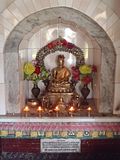
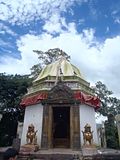
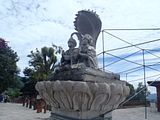
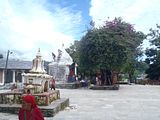
The third and final museum in Pokhara was the private Mountaineering Museum. The second we entered the compound we noticed how much better this building had been maintained than the government-owned Regional Museum -- and how much bigger it was. Francesca and I walked past a stone mountain, built for aspiring mountaineers to try their skills on. After Everest this hump had nothing on us! And so we by-passed it and headed straight for the entrance. Surprisingly, the museum wasn’t just dedicated to the Himalayas and its climbers -- it started with dioramas with information about the main tribes of Nepal.
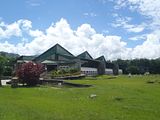
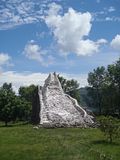
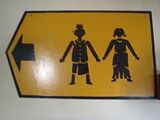
We read about the Tamang,Thakali, Chhantyals, Gurungs, Magars and Sherpas, which are all mountain people, living their lives in the vicinity of all the high tops. It was interesting to see their lives on display, with artifacts from their daily life spread out over quite a spacious area. Much more interesting was the second hall, which dealt with the mountains. It started off with a list of the 14 highest mountains in the world, along with anecdotes from the first summiteers and a great picture of that peak.
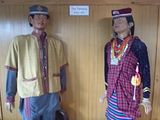
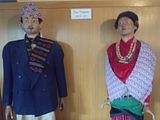
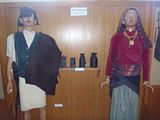
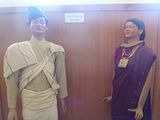
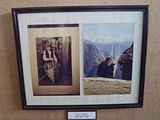
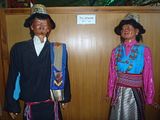
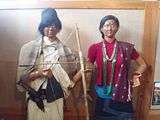
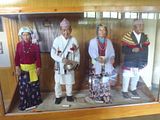
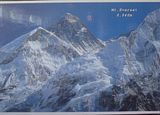
The next section had a rather boring wall with pictures of the flora of Nepal, followed by a much more appealing display of the fauna of the country. The hall of mountain activities discussed the myth surrounding the yeti and showed proof of its possible existence. It suddenly seemed a lot likelier that something is out there after reading and seeing all the information there. Also part of that same hall was a small exhibit on the actions of a Japanese mountaineer who’d decided to clean up Mt. Everest, which, after years of failed and succeeded attempts, had gathered quite a pile of junk along its flanks. A shocking 7000 kilograms of trash was brought down by Ken Noguchi and his teams. They even found the remains of a Sherpa who had died and had been left behind by his team. Insane!
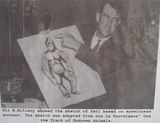
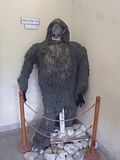
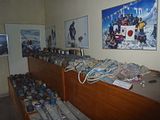
Upstairs, a final section was dedicated to the local tribes and mountains, with cool pictures of unique people, as well as stunning pictures of Mother Earth’s finest peaks. Francesca and I made our way to the exit and walked past the mini-mountain outside to the outdoor Cultural Museum. The name promised a lot, but delivered a little. A small, nearly empty hut built in a traditional style was the entire museum. A few quick snaps later we were on our way to the driver and ready to continue our exploration of Pokhara.
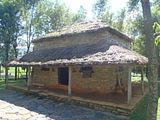
By now we were quite done with museums and felt like a rest. We had one more place to see in town and asked our driver to drop us off near the place Pokhara is most famous for: its lake. Phewa Tal is Nepal’s second-largest lake and is well-known for its beautiful reflections of the surroundings mountains in its often calm water. In the middle of the lake lies Pokhara’s most famous Hindu Temple, the Varahi Mandir. We paid a penny to get across to the tiny island in a wobbly rowboat. It took us only a few minutes to check out the 18th century Vishnu temple. The myriad pigeons were really annoying and had us looking for our rowboat-man to take us back. Then we walked back and chilled out for the rest of the day. Right after we came back I headed out to Caffé Concerto just around the corner where I picked up a pretty good pizza margherita for my girl and an apple sesame salad for me. Later that evening hunger struck again and I found another Italian restaurant to get some take away from. Bella Napoli was not as good as its competitor and the tagliatelle I got from there wasn’t finished entirely.
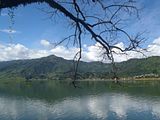
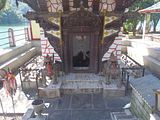
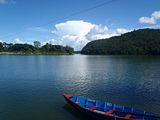
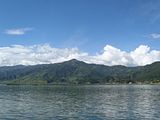
The 9th was a lovely, quiet day that we spent watching Simpsons and writing posts. Brunch came from the AM/PM Café again, and this time I brought back a Nutella croissant for Francesca, as well as a cheese and a tuna sandwich, with only the latter being for me. We thought about going to the World Peace Pagoda, perched on the mountains overlooking the lake, but didn’t feel like making the effort, also knowing we’d get the chance to see another one in Lumbini later on in our trip. Instead, we asked for a taxi to pick us up around 5:00 PM to take us to Sarangkot, a small village at the top of the valley for a gorgeous sunset. The bumpy ride to the top was well worth it, as we slowly got to see the sun disappearing behind clouds and mountains, whilst the last light lit the surroundings beautifully. We got to see glimpses of the Himalayan Mountains further in the background. Wonderful! When it started getting colder and darker we asked the driver to take us back to Pokhara and told him to drop us off at the Moondance Restaurant, where we picked up a delectable lasagna and the ‘healthy special’ (with tofu, brown rice and vegetables) which we took back to the guesthouse.
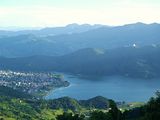
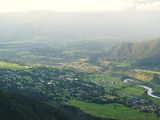
The 10th would see us leaving for Tansen, another rural town on the way down south to Lumbini that came highly recommended by the Lonely Planet. I had our bags ready, picked up snacks and other supplies from a supermarket and by 6:00 AM we were ready to be taken to the bus station. Suddenly Francesca asks me if we’d be able to go para-hawking. Para-hawking you ask? Well, para-hawking is a combination of para-gliding and hawking, where you are taken up into the air along with an instructor, who follows a bird of prey (hawks, vultures, or eagles) around for the best upward winds. You get to feed the bird in mid-air. Thinking we’d still have time to change our mind and could stay another day I asked the owner if it’d be possible to go para-hawking that day. The good man made some calls and found out the season hadn’t begun yet… No para-hawking for us. The bus station it was…
Instead of taking the bus we ended up in a taxi arranged by the Avalon House. We bade the staff farewell early that morning and told them we’d be back on the 21st. The drive to Bandipur was terribly uneventful, but fast with only a few short stops. Just past midday we arrived in Bandipur after a bit of a climb to get to the ridge. Bandipur, with its glorious 18th century Newari architecture and medieval atmosphere would definitely be worth spending a few hours in.

We’d read in the Lonely Planet we could get a guide to take us around the main sights for a good price, so our first goal was the Tourist Information Counter. On our way there we had to find a spot for a toilet-stop for Francesca and walked into one of the hostels in town. Whilst Francesca was surprised to find a Western toilet, I was even more surprised to read the owners were renting out their somewhat basic, but very livable rooms for the grand price of 1 rupee per night. We figured they’d just ask you to eat at their place, but regardless, that would be an amazing deal. Francesca and I thanked the owners for their hospitality and continued our walk on the cobblestones to the Counter.
The lady seemed to know exactly what I was talking about when I asked for a guide, and a man popped up next to her, ready to lead us around. I should’ve asked a few more questions, but didn’t and we ended up following the guide without really knowing what was about to happen. When the man started taking us outside of the village and finally explained we were about to be taken on a 4 hour hike to a nearby temple we quickly turned around and decided to just explore Bandipur on our own. I pulled out the Planet and cooked up a plan of attack.
On the main square we found the pretty Bindebasini Temple, dedicated to Durga. Every evening the village priest comes out and opens the doors of the ornately carved two-tiered temple. Across from it we spotted the Padma library, another typical 18th century Newari wooden building with carved windows and beams. After buying an umbrella to protect us from very likely incoming rain we headed to the Notre Dame School, established by Japanese nuns about 25 years ago. The school wasn’t very special, but seeing the kids playing in their uniforms was neat. Back on the main path we continued east and walked through Balabazaar, a striking arcade of shop-houses formerly occupied by Newari cloth merchants.



It was simply a pleasure walking through the quiet town, with a barely a soul in sight and nature along with its gorgeous views all around us. Francesca had us stop on several occasions to observe the wildlife. First we watched little ducklings having trouble getting out of the gutter, then there was a staircase full of chicken and lastly we stumbled upon some enormous spiders in their equally enormous spider webs. I managed to lead her past these, with the promise the sights behind them would be worth it. And indeed, the public washing area, known as Tin Dhara (three sprouts) looked interesting. Here, cool, clean spring water from the forest comes down the mountain and is still used by the locals today. We watched for a while, with Francesca freaking out over me wanting to try the water. Of course, in the end I didn’t…







Across from the spouts an ancient Shiva Temple, which, covered in moss, had integrated into its environs entirely. Our next goal was to get back to the village to find some more temples and sights. I had to get Francesca past the spiders again, and kept talking to her to make her forget they were there. My trick worked and she forgot all about them. We headed back to the square and had a drink in the Hill Way Café. The menu looked promising and we vouched to return after visiting the remainder of the sights.



I then took Francesca on a meandering walk to Tundikhel, a wide open space once used for trading. Bandipur had once been part of the trade route between India and Tibet, and traders had gathered here to haggle for goods before embarking on their long treks. Besides the history to the place it’s also an amazing viewpoint that reveals several of the Himalayas’ high peaks on cloudless days. We weren’t that lucky, but still got a wonderful view of the valley below. Furthermore, at the start of the Tundikhel stand five enormous fig trees. They’re not just ordinary trees, as we learned: in Nepali mythology the different types of fig trees are symbols for different Hindu gods, with Vishnu, Brahma and Hanuman all represented.



A longer walk would lead us back towards the main bazaar. It was a fairly steep climb at times and Francesca felt a little uncomfortable. We had no choice but to keep going and eventually ended up at a Martyrs Memorial, where I took a few pictures before returning to Francesca and continuing on. Just as we’d reached the highest point of the little climb and had to start descending again Francesca got even less excited about the slippery slopes she had to go down. By now we’d come so far that there was no sense in retracing our steps and we headed down, with me holding her hand. This didn’t stop her from still falling and landing on her bum, right in the middle of a little stream of water. Unavoidably, a wet ass was the result. We joked about that for a while and managed to get down otherwise unscathed.


On our way back Francesca and I had a look at the Baralthok, a small and abandoned settlement of the Magar people. Also along the way we found boring army barracks and finally the Khadga Devi Temple -- A 16th century shrine holding the sword of Mukunda Sen, a 16th century king of the ancient kingdom of Palpa. This one was actually worth the wet ass for and we stopped for a while to look at it and its surroundings. Back in town we made our way back to the Hill Way Café and sat down for a sandwich and a thukpa. They took a loooong time to arrive, but were well worth the wait.

Our driver had faithfully waited for us down at the parking lot and was all too eager to continue the drive to Pokhara. We later learned he still had to make his way back to Kathmandu that same day and had a long day ahead of us. Around 5:00 PM we arrived in Pokhara and had a look for the Peace Eye Guesthouse, which had been recommended to us. The owner led us to his second hostel in the adjoining building, the Rising Moon Guesthouse where we got a spacious fan-room for very little money. I lugged our backpacks upstairs, and we laid down on the comfortable bed to read up on Pokhara and rest up.

We thought it would be a good idea to immerse ourselves in some local culture on the first evening and found the ’best’ garden and dinner show place. The owner of the Peace Eye told us to head out around 7:00 PM, but we headed out a little early to get some good seats. This turned out to be unnecessary because it was an remained very quiet throughout our meal. Our table appeared okay and the service was pretty swift. Francesca ordered herself a butter chicken and I got some tacos, hoping the chefs could deliver on their promise of good Mexican food. Sadly, I was disappointed by the end result, whilst Francesca couldn’t complain about her decent curry and good naan. The show, however, was an absolute disaster -- the boxes were right in front of us, way too loud and distorted, the instruments and the singers off-key and the dancing out of tune and uncoordinated. What a hot mess… After we finished our food we quickly packed our bag and left.



For the 8th we had great plans. After a quick bite from the AM/PM Café down the road from our guesthouse I talked to a local cabdriver and asked him to take us around all of Pokhara for the day. After a bit of haggling we reached a deal and off we went. Our first stop would be the Regional Museum, devoted to the history and culture of the Pokhara Valley. Whilst the tiny museum had seen better days (about 2 decades ago) it was still interesting to walk through, watch the pictures, dioramas and artifacts. Highlights were a little native hut, clothing and an ancient collection of black-and-white pictures of tribes people. After a quick 15 minutes we were done with our first museum of the day and on our way to the second one.




The Gurkha Museum wasn’t very far away and proved to be much more interesting than the previous museum. The Gurkha Museum is dedicated to the Gurkhas, first known as a people of Nepal who took their name from the eighth century Hindu warrior-saint Guru Gorakhnath, and later used for the Nepalese branch of the British Indian Army. Here’s a little summary about the Gurkhas and their history: “In the Gurkha War (1814–1816) [the Gurkhas] waged war against the British East India Company army. The British were impressed by the Gurkha soldiers and after reaching a stalemate with the Gurkhas made Nepal a protectorate. Much later, they were granted the right to freely hire them as mercenaries from the interior of Nepal. After the British left India, Gorkhalis continued seeking employment in British and Indian forces, as officers and soldiers. Under international law, present-day British Gurkhas are not treated as mercenaries but are fully integrated soldiers of the British Army, operate in formed units of the Brigade of Gurkhas, and abide by the rules and regulations under which all British soldiers serve.” To this very day young Nepalese men undergo rigorous selection processes to become one of the select few to be accepted in the Gurkha training academy -- and a guaranteed better future for the soldier and his family.
The first floor of the museum was dedicated to the different battles the Gurkhas had taken part in. It started with the British Indian Army’s battles in and around Delhi, followed by contributions during both World Wars and much more recent conflicts such as the Gulf War and Iraq War. There were several stories about heroism from Gurkhas who’d gone out of their way for their fellow soldiers and thereby saved lives, whilst sometimes losing their own. Seeing their weapons (amongst which comes the kukhuri, their famous knife), reading those stories and seeing the pictures left quite an impression on me. Francesca, in the meantime, had started feeling progressively worse. I had her sit down for a while, whilst I explored the rest of the museum. The second floor was less interesting, being dedicated to the different companies, their flags and uniforms. I did get to put on their typical hat and made a quick picture of Gurkha Henk before returning to Francesca.





She’d started feeling a tiny bit better, but I still ran out to get her a nice, cold bottle of water. It helped her recover and made it possible for us to have a look at the Seti River, which over the centuries has carved an immensely deep canyon through the heart of the old city. It was pretty cool to see the river raging so many meters below us, whilst we already had descended several meters and were looking up at a small bridge above us. I took Francesca by the arm and led her back to the car, where we asked our driver to take us through Old Pokhara. We’d initially planned on walking around for a while, but with Francesca not feeling too great, were dissuaded and decided to observe the architecture from the comfort of our vehicle.



After checking out some more traditional Newari houses our driver stopped near Bhimsen Temple, a simple white temple in the middle of the road dedicated to the Newari god of trade and commerce. Not too far from the temple, the driver explained, a square is filled with shops selling baskets and ceramics. A little more interesting, but too hard for Francesca to get to, was the Bindhya Basini Temple on top of a small hill. I ventured out alone, promising Francesca I’d be back soon. As I rushed uphill to snap a few pictures a local student joined me to point out the highlights and tell me a little bit of the history of the place. I learned that the temple had been built in honor of Durga in the 17th century, and blood is still being shed here to this day. After a quick walkthrough I said bye to the student and went back to the car.




The third and final museum in Pokhara was the private Mountaineering Museum. The second we entered the compound we noticed how much better this building had been maintained than the government-owned Regional Museum -- and how much bigger it was. Francesca and I walked past a stone mountain, built for aspiring mountaineers to try their skills on. After Everest this hump had nothing on us! And so we by-passed it and headed straight for the entrance. Surprisingly, the museum wasn’t just dedicated to the Himalayas and its climbers -- it started with dioramas with information about the main tribes of Nepal.



We read about the Tamang,Thakali, Chhantyals, Gurungs, Magars and Sherpas, which are all mountain people, living their lives in the vicinity of all the high tops. It was interesting to see their lives on display, with artifacts from their daily life spread out over quite a spacious area. Much more interesting was the second hall, which dealt with the mountains. It started off with a list of the 14 highest mountains in the world, along with anecdotes from the first summiteers and a great picture of that peak.









The next section had a rather boring wall with pictures of the flora of Nepal, followed by a much more appealing display of the fauna of the country. The hall of mountain activities discussed the myth surrounding the yeti and showed proof of its possible existence. It suddenly seemed a lot likelier that something is out there after reading and seeing all the information there. Also part of that same hall was a small exhibit on the actions of a Japanese mountaineer who’d decided to clean up Mt. Everest, which, after years of failed and succeeded attempts, had gathered quite a pile of junk along its flanks. A shocking 7000 kilograms of trash was brought down by Ken Noguchi and his teams. They even found the remains of a Sherpa who had died and had been left behind by his team. Insane!



Upstairs, a final section was dedicated to the local tribes and mountains, with cool pictures of unique people, as well as stunning pictures of Mother Earth’s finest peaks. Francesca and I made our way to the exit and walked past the mini-mountain outside to the outdoor Cultural Museum. The name promised a lot, but delivered a little. A small, nearly empty hut built in a traditional style was the entire museum. A few quick snaps later we were on our way to the driver and ready to continue our exploration of Pokhara.

By now we were quite done with museums and felt like a rest. We had one more place to see in town and asked our driver to drop us off near the place Pokhara is most famous for: its lake. Phewa Tal is Nepal’s second-largest lake and is well-known for its beautiful reflections of the surroundings mountains in its often calm water. In the middle of the lake lies Pokhara’s most famous Hindu Temple, the Varahi Mandir. We paid a penny to get across to the tiny island in a wobbly rowboat. It took us only a few minutes to check out the 18th century Vishnu temple. The myriad pigeons were really annoying and had us looking for our rowboat-man to take us back. Then we walked back and chilled out for the rest of the day. Right after we came back I headed out to Caffé Concerto just around the corner where I picked up a pretty good pizza margherita for my girl and an apple sesame salad for me. Later that evening hunger struck again and I found another Italian restaurant to get some take away from. Bella Napoli was not as good as its competitor and the tagliatelle I got from there wasn’t finished entirely.




The 9th was a lovely, quiet day that we spent watching Simpsons and writing posts. Brunch came from the AM/PM Café again, and this time I brought back a Nutella croissant for Francesca, as well as a cheese and a tuna sandwich, with only the latter being for me. We thought about going to the World Peace Pagoda, perched on the mountains overlooking the lake, but didn’t feel like making the effort, also knowing we’d get the chance to see another one in Lumbini later on in our trip. Instead, we asked for a taxi to pick us up around 5:00 PM to take us to Sarangkot, a small village at the top of the valley for a gorgeous sunset. The bumpy ride to the top was well worth it, as we slowly got to see the sun disappearing behind clouds and mountains, whilst the last light lit the surroundings beautifully. We got to see glimpses of the Himalayan Mountains further in the background. Wonderful! When it started getting colder and darker we asked the driver to take us back to Pokhara and told him to drop us off at the Moondance Restaurant, where we picked up a delectable lasagna and the ‘healthy special’ (with tofu, brown rice and vegetables) which we took back to the guesthouse.


The 10th would see us leaving for Tansen, another rural town on the way down south to Lumbini that came highly recommended by the Lonely Planet. I had our bags ready, picked up snacks and other supplies from a supermarket and by 6:00 AM we were ready to be taken to the bus station. Suddenly Francesca asks me if we’d be able to go para-hawking. Para-hawking you ask? Well, para-hawking is a combination of para-gliding and hawking, where you are taken up into the air along with an instructor, who follows a bird of prey (hawks, vultures, or eagles) around for the best upward winds. You get to feed the bird in mid-air. Thinking we’d still have time to change our mind and could stay another day I asked the owner if it’d be possible to go para-hawking that day. The good man made some calls and found out the season hadn’t begun yet… No para-hawking for us. The bus station it was…

0 Comments:
Post a Comment
<< Home